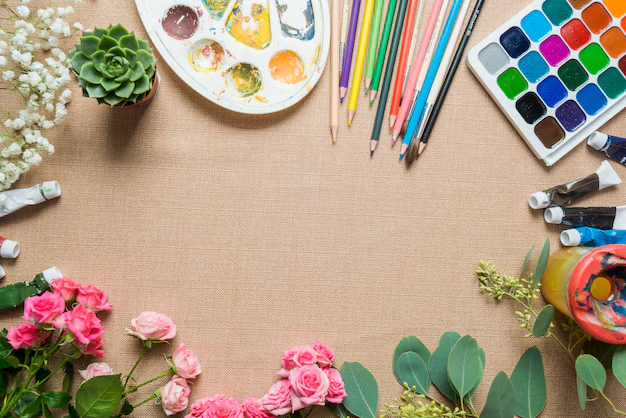The Timeless Appeal of Arts & Crafts: A Journey Through Creativity
Arts and crafts have long held a special place in human culture, offering a creative outlet for self-expression, relaxation, and skill development. From ancient pottery to modern-day DIY projects, the world of arts and crafts is vast and ever-evolving. Whether as a hobby, a career, or a form of personal expression, arts and crafts continue to captivate people across the globe. Their timeless appeal lies not just in their ability to produce beautiful objects, but in their power to connect us to tradition, stimulate our creativity, and provide a therapeutic escape from the stresses of modern life.
In this article, we explore the enduring charm of arts and crafts, how they have evolved over time, and why they remain a beloved activity for people of all ages.
1. A Creative Outlet for Self-Expression
One of the most significant aspects of arts and crafts is the freedom they offer for self-expression. Whether you’re painting a canvas, molding clay, or stitching a piece of fabric, crafting allows you to channel your emotions, thoughts, and imagination into tangible creations.
- Personalized Creations: The beauty of arts and crafts lies in the ability to create something uniquely yours. Each piece, whether it’s a handmade necklace or a hand-painted mug, carries the signature of the artist’s personality and creativity. This sense of ownership and pride in creating something from scratch is a fulfilling experience.
- Exploration of Artistic Styles: Arts and crafts encourage experimentation with different materials, techniques, and styles. Whether you’re drawn to abstract art, nature-inspired designs, or contemporary geometric patterns, there’s no limit to how you can explore and develop your unique creative voice.
2. Therapeutic and Stress-Relieving Benefits
In our fast-paced, technology-driven world, many people are seeking ways to unwind and reconnect with themselves. Arts and crafts provide a perfect way to achieve this, offering a therapeutic escape from the pressures of daily life.
- Mindfulness Through Crafting: Engaging in crafts encourages mindfulness, as it requires concentration and focus on the task at hand. This attention to detail allows individuals to immerse themselves fully in the present moment, helping to reduce stress and anxiety.
- Sense of Accomplishment: Completing a craft project, no matter how simple or intricate, provides a sense of achievement. The act of creating something from scratch can build confidence and offer a rewarding experience that boosts mental well-being.
- Creative Therapy: For many, arts and crafts serve as a form of emotional release. Whether it’s the repetitive motion of knitting or the flowing strokes of a paintbrush, these activities allow individuals to process their emotions in a calming, non-verbal way.
3. The Rich History of Arts & Crafts
Arts and crafts are not just modern-day hobbies—they are rooted in centuries of tradition. From the intricate tapestries of the Middle Ages to the hand-carved furniture of the Arts and Crafts Movement in the late 19th century, crafting has always played a significant role in human culture.
- The Arts and Crafts Movement: This movement, which began in Britain in the late 1800s, sought to revive traditional craftsmanship and reject the mass production that had come with the Industrial Revolution. Advocates of this movement, such as William Morris, emphasized the value of handmade goods, artistic integrity, and sustainability in design. This philosophy continues to influence arts and crafts today.
- Global Craft Traditions: Many cultures around the world have rich and diverse crafting traditions, from Japanese origami and Indian block printing to African beadwork and Native American pottery. Each culture has developed unique techniques and designs that reflect its history, values, and artistic sensibilities. As a result, arts and crafts offer a window into the diverse creative expressions of humanity across time and space.
4. Fostering Community and Connection
Arts and crafts often bring people together, whether through workshops, craft fairs, or social media groups. The communal aspect of crafting is one of its most appealing features, allowing people to share their passion, exchange ideas, and learn from one another.
- Collaborative Projects: Many crafting activities can be done in groups, from community quilting projects to large-scale mural painting. These collaborative endeavors encourage teamwork and help foster a sense of belonging and connection.
- Crafting as a Social Activity: In many cultures, crafts are passed down through generations, creating a sense of continuity and shared experience. Crafting with friends or family can strengthen bonds, create lasting memories, and even introduce younger generations to the rich traditions of handmade artistry.
- Online Communities: With the rise of social media, crafting communities have expanded globally. Websites like Pinterest, Etsy, and Instagram offer platforms for artists and crafters to showcase their work, connect with like-minded individuals, and exchange inspiration. These online spaces have democratized the arts and crafts world, making it easier for individuals to discover and share new techniques and ideas.
5. Sustainability and Eco-Friendly Crafting
In an era where sustainability is a growing concern, arts and crafts are aligning with the eco-friendly movement. Many crafters are turning to sustainable materials, upcycling, and eco-conscious techniques to create their projects.
- Upcycling and Repurposing Materials: One of the most popular trends in modern crafting is upcycling, or repurposing old or discarded materials into new creations. This not only reduces waste but also gives new life to items that would otherwise be thrown away. For example, turning an old sweater into a scarf or creating jewelry from vintage buttons can both be a creative and environmentally responsible practice.
- Sustainable Crafting Materials: Many crafters are choosing materials that are organic, recycled, or locally sourced. From natural dyes to biodegradable glues, the push for sustainability in arts and crafts encourages an eco-friendly approach to creativity.
6. The Future of Arts & Crafts
As technology advances, so too does the world of arts and crafts. 3D printing, laser cutting, and digital design are making their way into the crafting world, offering new possibilities for artists and crafters to experiment with. However, despite these technological advancements, the core appeal of arts and crafts—creativity, self-expression, and hands-on engagement—remains timeless.
The future of arts and crafts is about blending traditional techniques with modern innovation, creating a new era of creativity where the possibilities are endless.
Conclusion
Arts and crafts are more than just a way to pass the time—they are an integral part of human culture and self-expression. Whether you’re a seasoned artisan or someone just beginning their creative journey, arts and crafts offer something for everyone: a sense of accomplishment, a therapeutic escape, and a connection to both tradition and innovation.
The appeal of arts and crafts is timeless, and as long as people continue to seek out creative outlets, the world of handmade artistry will remain a vibrant and essential part of our lives.

